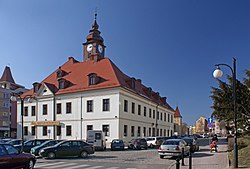Lubin
| Lubin | |||
|---|---|---|---|

Town Hall
|
|||
|
|||
| Coordinates: 51°24′N 16°12′E / 51.400°N 16.200°E | |||
| Country | Poland | ||
| Voivodeship | Lower Silesian | ||
| County | Lubin County | ||
| Gmina | Lubin (urban gmina) | ||
| Established | 12th century | ||
| City rights | 1295 | ||
| Government | |||
| • Mayor | Wojciech Rutkowski | ||
| Area | |||
| • Total | 40.77 km2 (15.74 sq mi) | ||
| Population (2012) | |||
| • Total | 74,886 | ||
| • Density | 1,800/km2 (4,800/sq mi) | ||
| Time zone | CET (UTC+1) | ||
| • Summer (DST) | CEST (UTC+2) | ||
| Postal code | 59-300 | ||
| Area code(s) | +48 76 | ||
| Car plates | DLU | ||
| Website | http://www.lubin.pl | ||
Lubin, [ˈlubʲin] (German: Lüben) is a town in Lower Silesian Voivodeship in south-western Poland. From 1975–1998 it belonged to the former Legnica Voivodeship. Lubin is the administrative seat of Lubin County, and also of the rural district called Gmina Lubin, although it is not part of the territory of the latter, as the town forms a separate urban gmina. As of the 2009 census, the town had a total population of 74,552.
Lubin is situated on the Zimnica river in the Lower Silesian historical region, about 71 kilometres (44 miles) northwest of Wrocław and 20 km (12 miles) north of Legnica.
The town is one of the major industrial locations in Lower Silesia, with the headquarters of the third-largest Polish corporation, the KGHM Polska Miedź mining company.
The area of Lubin lies midway between the main settlements of two West Slavic Ślężanie tribes, the Dziadoszanie and the Trzebowianie, whose lands were both subdued by King Mieszko I of Poland about 990. It is unclear which of the two tribes, if either, founded the town. One legend states that the town derives its name from Luba, a young man credited with slaying a giant bear that had been terrifying the inhabitants. A papal bull dated to circa 1155 mentions Lubin as one of 13 Silesian castellanies.
According to legend the Polish voivode Piotr Włostowic of Dunin (1080–1153) had a fieldstone church built on the hill in the west of Lubin, where about 1230 a castellany and a village arose that until today is called the Old Town (Polish: Stary Lubin). The settlement in the Duchy of Głogów was first mentioned under the Old Polish name of Lubin in a 1267 deed by Pope Clement IV as a fiefdom of Trzebnica Abbey.
...
Wikipedia



